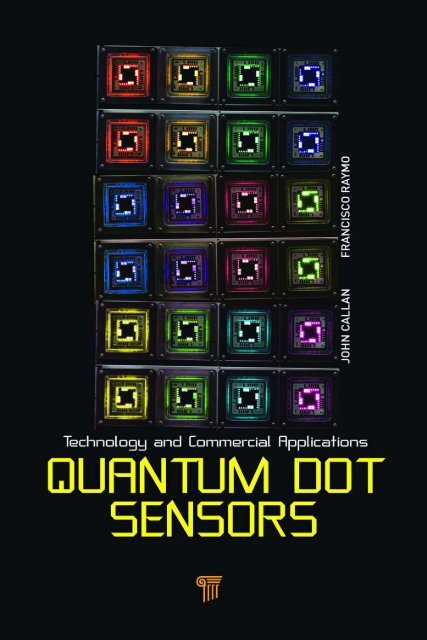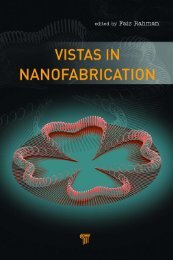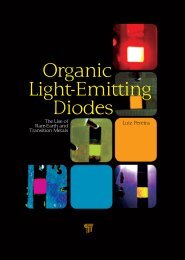Download PDF - Pan Stanford Publishing
Download PDF - Pan Stanford Publishing
Download PDF - Pan Stanford Publishing
Create successful ePaper yourself
Turn your PDF publications into a flip-book with our unique Google optimized e-Paper software.
QDS_TP.indd 1<br />
11/16/12 8:07:50 PM
Published by<br />
<strong>Pan</strong> <strong>Stanford</strong> <strong>Publishing</strong> Pte. Ltd.<br />
Penthouse Level, Suntec Tower 3<br />
8 Temasek Boulevard<br />
Singapore 038988<br />
Email: editorial@panstanford.com<br />
Web: www.panstanford.com<br />
British Library Cataloguing-in-Publication Data<br />
A catalogue record for this book is available from the British Library.<br />
Quantum Dot Sensors: Technology and<br />
Commercial Applications<br />
Copyright © 2013 <strong>Pan</strong> <strong>Stanford</strong> <strong>Publishing</strong> Pte. Ltd.<br />
All rights reserved. This book, or parts thereof, may not be reproduced in any<br />
form or by any means, electronic or mechanical, including photocopying,<br />
recording or any information storage and retrieval system now known or<br />
to be invented, without written permission from the publisher.<br />
For photocopying of material in this volume, please pay a copying fee<br />
through the Copyright Clearance Center, Inc., 222 Rosewood Drive,<br />
Danvers, MA 01923, USA. In this case permission to photocopy is not<br />
required from the publisher.<br />
ISBN 978-981-4316-00-2 (Hardcover)<br />
ISBN 978-981-4364-61-4 (eBook)<br />
Printed in the USA
Contents<br />
Preface<br />
ix<br />
1. Quantum Dot Synthesis Methods 1<br />
Yurii K. Gun’ko and Stephen Byrne<br />
1.1 Introduction 1<br />
1.2 High-Temperature Synthesis in Organic Solvents 2<br />
1.2.1 Organometallic Synthesis 2<br />
1.2.2 QD Synthesis from Non-Organometallic<br />
Precursors 7<br />
1.2.3 Microwave Synthesis 10<br />
1.2.4 Transfer of QDs from Organic to<br />
Aqueous Phase 11<br />
1.3 Direct Aqueous Syntheses of QDs 14<br />
1.4 Micellar Synthetic Approaches 17<br />
1.5 Solvothermal Approaches 18<br />
1.6 QD Luminescence Improvement 20<br />
1.6.1 Surface Passivation and Core–Shell<br />
Structure Formation 20<br />
1.6.2 Photoetching of QDs 24<br />
1.6.3 Role of Capping Ligands 27<br />
1.7 Further Functionalisation and Bioconjugation of QDs 30<br />
1.8 Concluding Remarks and Future Outlook 33<br />
2. Biocompatible CdSe–ZnS Core–Shell Quantum Dots 43<br />
Ibrahim Yildiz and Françisco M. Raymo<br />
2.1 Semiconductor Quantum Dots 43<br />
2.2 CdSe–ZnS Core–Shell Quantum Dots 44<br />
2.3 Ligand Exchange 46<br />
2.4 Ligand Interdigitation 51<br />
2.5 Bioconjugation 52
vi<br />
Contents<br />
2.6 Cytotoxicity 56<br />
2.7 Conclusions 56<br />
3. Electrochemical Properties of Semiconductor<br />
Quantum Dots 63<br />
Matteo Amelia, Alberto Credi, and Serena Silvi<br />
3.1 Introduction 63<br />
3.2 Basic Electronic Properties of QDs 64<br />
3.3 Overview of Electrochemical Techniques Employed<br />
for the Investigations on QDs 67<br />
3.3.1 Voltammetry 68<br />
3.3.2 Electrochemiluminescence 70<br />
3.3.3 Spectroelectrochemistry 71<br />
3.4 CdSe Nanocrystals 72<br />
3.4.1 Voltammetry 72<br />
3.4.2 Electrochemiluminescence 78<br />
3.4.3 Spectroelectrochemical Measurements 82<br />
3.5 CdTe Nanocrystals 85<br />
3.5.1 Voltammetric Measurements 85<br />
3.5.2 Electrochemiluminescence 87<br />
3.5.3 Spectroelectrochemical Measurements 89<br />
3.6 Nanocrystals Functionalized with Electroactive<br />
Molecules 89<br />
3.7 Applications of Electroactive Quantum Dots 92<br />
3.7.1 Electrochemical QD Sensors 92<br />
3.7.2 Electrochemiluminescent QD Sensors 95<br />
3.7.3 QD-Based Electrochemical Signal Transducers 99<br />
3.7.4 Other Systems 101<br />
3.8 Conclusions 104<br />
4. Electron Transfer Quenching for Biosensing with<br />
Quantum Dots 111<br />
David E. Benson, Stacey R. De Haan, Chase E. Hulderman,<br />
and Marla D. Swain<br />
4.1 Electron Transfer Quenching 113<br />
4.2 Initial Receptor-Based Biosensors 119
Contents<br />
vii<br />
4.3 Protease-Based Biosensors Show Multiplexing Ability 121<br />
4.4 Recent Distance-Dependent Biosensors<br />
Demonstrate Analyte Modularity 122<br />
4.5 Toward Biological Imaging of Analyte Concentrations 125<br />
5. Quantum Dot Probes Based on Energy<br />
Transfer Mechanisms 135<br />
John F. Callan, Bridgeen McCaughan, Colin Fowley, Narinder Singh,<br />
Navneet Kaur, and Suban Sahoo<br />
5.1 Introduction 135<br />
5.2 pH, Ion and Small Molecule FRET Sensors 138<br />
5.3 QD-Peptide/Oligonucleotide FRET Sensors 148<br />
5.4 QD–Antibody Conjugates 152<br />
5.5 QD FRET Probes for Enzyme Activity 154<br />
5.6 Conclusions 158<br />
6. Quantum Dot Reactive Oxygen Species Generation<br />
and Toxicity in Bacteria: Mechanisms and<br />
Experimental Pitfalls 163<br />
Jay Nadeau<br />
6.1 Overview 163<br />
6.2 Quantum Dots Cores, Shells, and Caps 164<br />
6.3 Band Edge Energies and Possible Reactions<br />
in Solution 168<br />
6.4 Measuring Reactive Oxygen Species in the<br />
Presence of QDs 171<br />
6.5 Pitfalls: Dyes to Use with Caution 176<br />
6.6 Deliberate Toxicity: Photosensitized QDs 177<br />
6.7 Toxicity to Bacteria: Introduction 181<br />
6.8 CdSe Core QDs 184<br />
6.9 CdSe/ZnS and Photosensitization 193<br />
6.10 Discussion 196<br />
Index 205
Preface<br />
The past two decades have witnessed the emergence of semiconductor<br />
quantum dots (QDs) as versatile nanoparticles with a<br />
wide range of applications from energy-efficient lighting and displays<br />
to biomolecular sensors. This book focuses on the incorporation of<br />
QDs into optical- and electrochemical-based sensing systems for<br />
chemical and biologically relevant target analytes. This arena<br />
has traditionally been dominated by organic-dye-based sensors.<br />
However, the realisation of the impressive optical properties of<br />
QDs has seen them emerge as serious rivals to their all-organic<br />
counterparts. QDs are now commercially available from many<br />
different vendors with a wide range of surface chemistries suitable<br />
for derivatisation.<br />
In this book, we chart the progress in the development of QDs<br />
over the past two decades with a particular focus on the use of<br />
CdS-, CdSe- and CdTe-based QDs in sensing systems. Chapter<br />
1 details the range of synthetic methods used to prepare QDs,<br />
including solvothermal, aqueous-based, microwave-assisted and<br />
micellar approaches with the benefits and potential drawbacks<br />
of each approach outlined. The preparation of biocompatible QDs<br />
is discussed in Chapter 2, which details how native hydrophobic<br />
QDs can be transferred into aqueous solution using methods such<br />
as ligand exchange and amphiphilic polymer encapsulation. Again,<br />
the advantages and disadvantages of the different approaches for<br />
the preparation of biocompatible QDs are outlined.<br />
Modifying the surface of QDs with organic ligands or biomolecules<br />
is central to the development of QD-based sensors. This surface<br />
derivatisation can have a dramatic effect on the electrochemical<br />
properties of the semiconductor nanoparticle and affect its optical<br />
performance. Chapter 3 discusses the electrochemical properties<br />
of core and core–shell QDs and how these properties can change<br />
depending on the nature and thickness of the shell and the type<br />
of ligands attached to its surface. This chapter also details how<br />
the electroactivity of QDs can be exploited in the development of<br />
electrochemical-based sensing systems.
Preface<br />
Although examples of electrochemical-based QD sensing<br />
are emerging, optical-based sensing methods still dominate the<br />
literature. The modulation of the QD optical signal in the analyte-free<br />
and bound states can be controlled by electron transfer or energy<br />
transfer mechanisms. Chapter 4 discusses how electron transfer<br />
between the QD and attached ligands or between the QD and the<br />
analyte itself (if the analyte is redox active) can be utilised to develop<br />
QD-based sensors. Chapter 5 details how QDs can be utilised as<br />
energy donors and integrated with a wide range of energy acceptors<br />
in energy transfer (FRET)-based sensors. Sensors for a wide range<br />
of analytes are discussed, ranging from simple protons to complex<br />
biomolecules. Finally, Chapter 6 discusses how differences in the<br />
core–shell composition of QDs and physical/chemical factors such<br />
as the size and nature of attached ligands can influence their toxicity<br />
in prokaryotic cells.<br />
The aim of this book is to give the reader a detailed overview of<br />
how QDs can be prepared and incorporated as the signalling unit<br />
in electrochemical/optical-based sensors. The editors are indebted<br />
to the chapter authors for their contributions, the <strong>Pan</strong> <strong>Stanford</strong><br />
publishing group and the Universities of Ulster and Miami for their<br />
assistance and support. We hope this book will be a useful reference<br />
text and will help in promoting QDs as viable alternatives in the<br />
design of optical sensors.<br />
John F. Callan<br />
Françisco M. Raymo<br />
Winter 2012
















